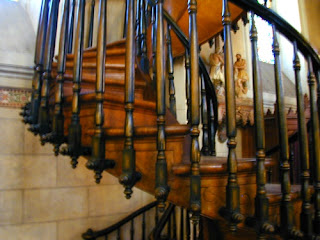
Although it has been the subject of legend and rumor, and the circumstances surrounding its construction and its builder are considered miraculous by the Sisters of Loretto and many visitors,[2] explanations for many of the claimed "mysteries" have been found.

In 1872 Jean-Baptiste Lamy, the Bishop of the Santa Fe Archdiocese, commissioned the building of a convent chapel to be named Our Lady of Light Chapel, which would be in the care of the Sisters of Loretto. The chapel was designed by French architect Antoine Mouly in the Gothic Revival style, complete with spires, buttresses, and stained glass windows imported from France. Although it was built on a much smaller scale, the chapel bears an obvious resemblance to the Sainte-Chapelle in Paris.

Many carpenters were called upon, but they all shook their heads, saying a stairway required much more space than was available, and suggested two alternatives; use a ladder or tear the whole thing down and start over.
But the Sisters, being women of God, were not discouraged. Once again they called upon St. Joseph with a novena, and on the tenth day an old gray-haired man, carrying only a toolbox, appeared on a donkey, and asked if he could build the staircase. The Sisters, ecstatic and grateful, gave their consent.
Inside the old man's toolbox was only a hammer, a saw and a T square. It took him eight months to complete the beautiful and sturdy spiral staircase using NO NAILS and NO CENTER SUPPORT.

Knowing they had been blessed, the Sisters gave thanks, but when they went to pay the carpenter, he had disappeared, and when they went to to the lumber company, no one knew of any purchase, nor did they carry the type of wood that was used on the staircase.
The church, is cautious about spreading rumors of supernatural intervention, but the Sisters know that the miracle staircase is an answer to their novena to St. Joseph. Some even think the gray-haired man on the donkey was St. Joseph himself.
Explanations for the mystery
The subject of rumor and legend for over a hundred years, the riddle of the carpenter's identity was finally solved in the late 1990s by Mary Jean Straw Cook, author of Loretto: The Sisters and Their Santa Fe Chapel (2002: Museum of New Mexico Press). His name was Francois-Jean "Frenchy" Rochas, an expert woodworker who emigrated from France and arrived in Santa Fe around the time the staircase was built. In addition to evidence that linked Rochas to another French contractor who worked on the chapel, Cook found an 1895 death notice in The New Mexican explicitly naming Rochas as the builder of "the handsome staircase in the Loretto chapel."

Johann Hadwiger, a German woodworker, was once credited with the design and construction of the stairs. The source of this claim, Johann's grandson Oscar Hadwiger, later admitted he had no proof of the claim.
Some more recent studies are critical of the supposed "miraculous" nature of the staircase. It has been claimed to be unsafe since its helix shape may make it oscillate just like a very large spring. As to its apparent ability to stand without a newel (central pole) support, this argument proceeds on a faulty premise that all spiral staircases need a central support. In fact, they do not, and lateral or outer supports can be effectively substituted for a central support. However, this staircase appears to have a concealed central support, an inner wood stringer of a very small radius that, because of its small size, functions effectively as a central pole. This technique is well known. The staircase also has an additional outer support to one of the columns that support the loft. This support was added later. The staircase is made of spruce, but insufficient sampling makes it impossible to conclusively affirm (or deny) the source of this wood.
The Chapel Today
The Loretto Chapel is now a museum and no longer functions as a church, but weddings may be arranged. It is owned by a private company. There is an entrance fee for the chapel.
------------
Source:
http://en.wikipedia.org/wiki/Loretto_Chapel
http://www.funtripslive.com/santa_fe/miracle_staircase/staircase.htm



Though it seems a mysterious staircase, it is very interesting in terms of design! If it is working now, I want to walk on it!
ReplyDeleteI heard about this staircase when I was about 12-13 years old on Unsolved Mysteries. Over the past years I forgot about it. Once and awhile something would come up and I would remember, but that's all.
DeleteI don't know what made me think about it tonight but I've been reading about staircase's all night!!
Please correct the title.
ReplyDeleteThis comment has been removed by the author.
ReplyDeleteThis comment has been removed by the author.
ReplyDeleteI've visited the chapel twice. The staircase is an amazing work of art. I believe an unseen hand aided in building it.
ReplyDeleteGIVE credit to the MAN who built it!
Delete